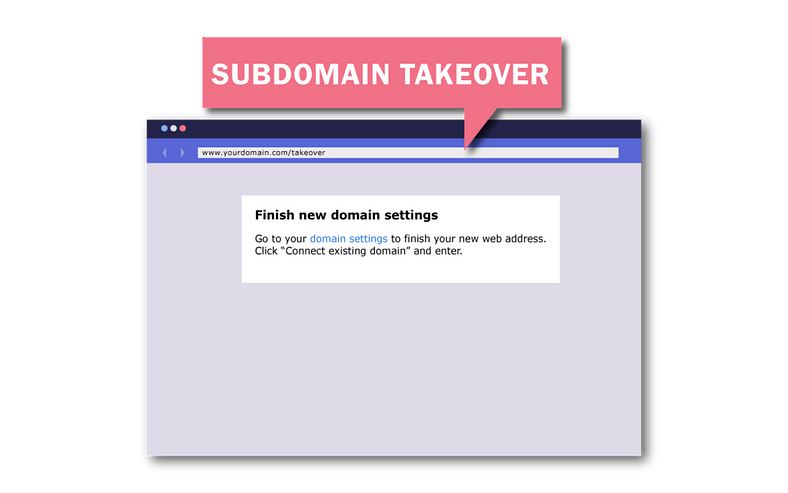Subdomain hacking is a cyber attack that involves exploiting vulnerabilities in subdomains to gain unauthorized access to a website or network. Subdomains are often used to organize web content or to create unique landing pages for specific campaigns or products. However, they can also be vulnerable to attacks if not properly secured.
In this article, we will discuss subdomain hacking in detail, including its methodology and prevention strategies.
Understanding the Threat of Subdomain Hacking
Subdomain hacking can be a serious threat to businesses and organizations that rely on their online presence. Attackers can use subdomain hacking to gain access to sensitive information, deface the website, or distribute malware.
Subdomain takeover is a common subdomain hacking technique where attackers take control of a subdomain by pointing it to their own server or IP address. This allows them to intercept and manipulate traffic intended for the legitimate subdomain, giving them access to sensitive data such as login credentials or customer information.
Another technique used in subdomain hacking is subdomain enumeration, where attackers use tools to scan a domain for subdomains that may have been overlooked or left unsecured. Attackers can use this information to launch further attacks, such as phishing or social engineering attacks.
Domain
➜ A domain is the address where a website can be accessed on the internet. It usually consists of two parts: the domain name and the top-level domain (TLD), separated by a dot (.). For example, “google.com” is a domain, where “google” is the domain name and “.com” is the TLD. Other examples of TLDs include “.org”, “.net”, “.gov”, and “.edu”.

Subdomain
➜ A subdomain is a secondary domain that is part of a larger domain. It is created to organize and structure a website into specific sections, and is created using the parent domain name followed by a prefix. For example, if a website’s domain is “example.com”, a subdomain for a section of the website could be “blog.example.com” or “support.example.com”. Subdomains can be used to separate content or functionality, making it easier for users to find what they’re looking for and for website administrators to manage the site.

Is it possible hack Subdomain ?
➜ Yes, it is possible to hack a subdomain if there are vulnerabilities present in the web application or the server hosting it. Hackers can exploit these vulnerabilities to gain unauthorized access and control over the subdomain. It is important for organizations to regularly assess and secure their subdomains to prevent hacking attempts.

Subdomain Enumeration ?
➜ Subdomain enumeration is the process of discovering the subdomains of a target domain. This information can be used by security researchers to identify potential targets for further testing or by attackers to launch attacks on subdomains that are less well-protected. Subdomain enumeration can be performed using a variety of tools, including automated scripts, search engines, and other reconnaissance techniques. The goal of subdomain enumeration is to gather as much information as possible about a target’s subdomains and their associated IP addresses, server configurations, and other details. This information can then be used to identify potential weaknesses and vulnerabilities that can be exploited in an attack.

Subdomain Takeover
➜ Subdomain takeover is a type of security vulnerability that occurs when a subdomain of a domain is pointing to a service (such as a content delivery network (CDN) or a cloud hosting provider) that is no longer in use or has been misconfigured. This allows an attacker to take control of the subdomain and use it for malicious purposes, such as phishing or distributing malware.
For example, if a subdomain of a company’s website is pointing to a CDN that is no longer in use, an attacker could register an account with the CDN provider and claim the subdomain. This would allow the attacker to host malicious content on the subdomain and potentially trick users into visiting the site and exposing themselves to the attacker’s payload.
It is important for organizations to regularly monitor their subdomains and ensure that they are properly configured to prevent subdomain takeovers. This can involve configuring appropriate DNS settings, monitoring for expired or misconfigured services, and regularly auditing the security of their web applications.

How to find Subdomains of a Domain / Website ?
➜ To find a website’s subdomain, you can do the following:
Check the URL: A subdomain is indicated by the text before the main domain name, separated by a dot. For example, in “subdomain.example.com,” “subdomain” is the subdomain.
Use online tools: There are various online tools that can help you find subdomains of a website, such as “Subdomain Finder” or “Sublist3r”. Simply enter the main domain name and the tool will generate a list of subdomains.
Use command line tools: You can also use command line tools like “nslookup” or “dig” to retrieve information about subdomains associated with a website.
It is important to note that not all websites have subdomains, and some may have many.

Subdomain Hacking process:
➜ The process of hacking a subdomain can involve several steps:
Vulnerability scanning: Use automated tools to scan the target subdomain for known vulnerabilities and identify potential attack vectors. This can include identifying misconfigured servers, outdated software, and other security weaknesses.
Exploitation: Attempt to exploit the vulnerabilities identified in the previous step to gain unauthorized access to the target subdomain. This may involve exploiting a vulnerability in the web application or the server hosting the subdomain.
Post-exploitation: After gaining access, the attacker may attempt to escalate their privileges, exfiltrate sensitive data, or use the subdomain for malicious purposes such as hosting phishing pages or distributing malware.
It is important to note that the success of these steps depends on the presence of vulnerabilities and the skill of the attacker. Organizations can reduce the risk of subdomain hacking by regularly assessing and securing their subdomains, implementing security best practices, and staying up to date with the latest patches and software updates.

How can a Hacker gain access to a Subdomain?
➜ A hacker can gain access to a subdomain in several ways, including:
Brute force attacks: A hacker can use a program to repeatedly guess login credentials until they are able to access the subdomain.
Vulnerability exploitation: A hacker can find a vulnerability in the software or code of the subdomain and exploit it to gain access.
Social engineering: A hacker can trick an employee into giving them access by posing as a trustworthy person or by tricking the employee into downloading malware.
Domain spoofing: A hacker can create a fake subdomain that is a replica of the original subdomain and trick users into entering their login credentials.
Man-in-the-middle attacks: A hacker can intercept and modify communication between the user and the subdomain, allowing them to gain access.
Misconfigured DNS settings: If the DNS settings of the subdomain are not properly configured, a hacker may be able to access the subdomain by redirecting traffic to a malicious server.

What are the common techniques used for Subdomain Hacking?
➜ The common techniques used for subdomain hacking are:
Subdomain Takeover: A hacker takes over a subdomain that is no longer in use or is misconfigured, giving them control of the subdomain and its content.
Zone Transfer: A hacker can retrieve the DNS information of a subdomain by sending a request to the domain name server (DNS).
DNS Spoofing: A hacker can manipulate the DNS server to redirect traffic from the legitimate subdomain to a fake subdomain.
Cross-Site Scripting (XSS): A hacker can inject malicious code into the subdomain and steal sensitive information from users who access the subdomain.
SQL Injection: A hacker can manipulate the subdomain’s database by injecting malicious SQL code, allowing them to access and modify sensitive information.
Directory Traversal: A hacker can exploit vulnerabilities in the subdomain’s file system and access sensitive information or files.
Phishing: A hacker can create a fake subdomain and trick users into entering their login credentials, giving the hacker access to sensitive information.
HTTP Parameter Pollution: A hacker can manipulate the subdomain’s parameters to execute malicious code or access sensitive information.
Remote Code Execution: A hacker can execute code on the subdomain’s server and take control of the subdomain.
Malware and Virus Infection: A hacker can infect the subdomain with malware or viruses, allowing them to steal sensitive information and control the subdomain.

How can organizations detect if their Subdomain has been hacked?
➜ Organizations can detect if their subdomain has been hacked by implementing the following steps:
Monitoring: Regularly monitoring the subdomain for unusual activity, such as an increase in traffic or changes in content.
Scanning: Using security tools to scan the subdomain for vulnerabilities, malware, and other signs of hacking.
Analyzing Logs: Reviewing server logs for unusual activity, such as unauthorized access or attempted attacks.
Checking External Sources: Checking external sources, such as website security forums and blacklists, for any reported instances of the subdomain being hacked.
Monitoring DNS Changes: Keeping track of changes in the subdomain’s DNS settings and monitoring for any unauthorized changes.
Email and Social Media Monitoring: Monitoring company email and social media accounts for any suspicious messages or posts.
Installing Security Software: Installing and regularly updating security software, such as firewalls and anti-virus software, to prevent hacking attempts.
Conducting Regular Security Audits: Conducting regular security audits to identify and remediate any vulnerabilities in the subdomain.
Conducting Penetration Testing: Engaging a third-party security company to conduct a penetration test, simulating a real-world hacking attempt to identify and remediate vulnerabilities.
Training Employees: Regularly training employees on security best practices and educating them on how to identify and respond to hacking attempts.

What steps can take to improve subdomain security and prevent hacking attacks?
➜ Preventing subdomain hacking requires a combination of technical and organizational measures. Here are some strategies that organizations can implement to protect their subdomains:
- Monitor subdomains: Regularly monitor subdomains to identify any unauthorized changes or takeovers. This can be done using tools like Subdomain Alert or Intrigue Core.
- Use strong passwords: Ensure that all subdomains have strong and unique passwords that are regularly updated. Use a password manager to generate and store complex passwords.
- Implement DNSSEC: Domain Name System Security Extensions (DNSSEC) provide a layer of security to DNS by digitally signing data to prevent tampering or spoofing.
- Perform regular vulnerability scans: Use vulnerability scanning tools to identify potential weaknesses or misconfigurations in subdomains.
- Educate employees: Train employees on best practices for password management and phishing awareness. This can reduce the risk of social engineering attacks that exploit human error.
I hope you have learned something new today.🧑💻
Conclusion
Subdomain hacking can be a serious threat to organizations that rely on their online presence. Attackers can use subdomain takeover or subdomain enumeration to gain access to sensitive information or distribute malware. Preventing subdomain hacking requires a combination of technical and organizational measures, including regular monitoring, strong passwords, DNSSEC, vulnerability scanning, and employee education. By implementing these strategies, organizations can better protect their subdomains and reduce the risk of subdomain hacking attacks.
